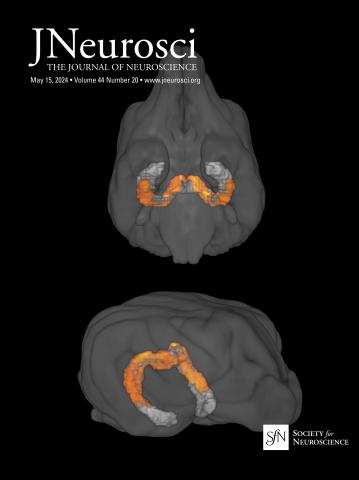Purkinje cell spatial correlation dynamics are key to cerebellar cortical contributions to behavior.
IF 4.4
2区 医学
Q1 NEUROSCIENCES
引用次数: 0
Abstract
A major challenge in cerebellar physiology is determining how the stereotypic, conserved circuitry of the cerebellar cortex, with its dominant parasagittal and transverse architectures, underlies its fundamental computations and contributions to behavior. Recent advances have allowed for the resolution of Purkinje cell dendritic activity at large scales, but the full roles of these Purkinje cell dynamics during behavior remain undetermined. To interrogate Purkinje cell dynamics at the population level during behavior, we implemented a novel approach for awake, chronic, wide-field Ca2+ imaging of the cerebellar cortex. We performed wide-field cerebellar recordings in mice of both sexes exhibiting sparse expression of the Ca2+ indicator GCaMP6s, which importantly allowed for the resolution of both dendritic and somatic Purkinje cell activity. Blind source separation of wide-field dynamics using spatial independent component analysis (sICA) extracts components consisting of either Purkinje cell dendrites or somata, with distinct activity and spatial properties. These independent components (ICs) tend to be either parasagittally organized and likely reflective of dendritic activity, or more spatially distributed populations of Purkinje cell somata. We observe broad, bilateral activation of both these dendritic and somatic ICs during behavior, but they exhibit distinct and divergent patterns of spatial correlations occurring primarily along the parasagittal and transverse directions, consistent with the main geometry of the cerebellar cortex. Somatic correlation dynamics are robustly modulated by prediction errors and reflect ultimate behavioral outcomes. These results provide a novel link between cerebellar structure and function, with the correlation dynamics of Purkinje cell activity a key feature during behavior.Significance statement The cerebellar cortex exhibits highly conserved, elegant cytoarchitecture, but a full understanding of how this organization contributes to cerebellar processing is limited. We performed wide-field Ca2+ recordings of the primary output neurons of the cerebellar cortex, Purkinje cells, and find that they are organized into distinct networks, which are either parasagittally organized or distributed populations of somatic activity. While both networks are highly engaged during behavior, they exhibit distinct spatial correlation dynamics consistent with the main geometry of the cerebellar cortex, with somatic correlation dynamics conveying information about prediction error and behavioral outcomes. Together, these results provide new insights into the functional organization of Purkinje cells and implicate somatic network correlation dynamics as a key feature of cerebellar processing.浦肯野细胞空间相关动力学是小脑皮层对行为贡献的关键。
小脑生理学的一个主要挑战是确定小脑皮层固有的、保守的电路,以及其主导的副矢状和横向结构,是如何构成其基本计算和对行为的贡献的。最近的进展已经允许大规模的浦肯野细胞树突活动的分辨率,但这些浦肯野细胞动力学在行为中的全部作用仍然不确定。为了在行为期间在群体水平上询问浦肯野细胞动力学,我们实施了一种新的方法,用于小脑皮层的清醒,慢性,宽视场Ca2+成像。我们对雌雄小鼠进行了广域小脑记录,显示Ca2+指示剂GCaMP6s的稀疏表达,这重要地允许树突状和体细胞浦肯野细胞活性的分辨率。利用空间独立成分分析(sICA)进行宽视场动力学盲源分离,提取出浦肯野细胞树突或体细胞组成的组分,这些组分具有不同的活性和空间特性。这些独立成分(ic)倾向于要么是副枝状组织,可能反映树突活动,要么是更多空间分布的浦肯野细胞体群体。我们观察到,在行为过程中,这些树突和躯体ic都有广泛的双侧激活,但它们表现出明显的、不同的空间相关性模式,主要沿着副矢状面和横向方向发生,与小脑皮层的主要几何形状一致。躯体相关动力学受到预测误差的稳健调节,并反映最终的行为结果。这些结果提供了小脑结构和功能之间的新联系,浦肯野细胞活性的相关动力学是行为过程中的关键特征。小脑皮层表现出高度保守、优雅的细胞结构,但对这种组织如何促进小脑加工的充分理解是有限的。我们对小脑皮层浦肯野细胞的初级输出神经元进行了宽视场Ca2+记录,发现它们被组织成不同的网络,这些网络要么是副矢状组织的,要么是分散的躯体活动群体。虽然这两个网络在行为过程中都高度参与,但它们表现出与小脑皮层主要几何形状一致的明显空间相关动态,其中躯体相关动态传递有关预测误差和行为结果的信息。总之,这些结果为浦肯野细胞的功能组织提供了新的见解,并暗示体细胞网络相关动力学是小脑加工的关键特征。
本文章由计算机程序翻译,如有差异,请以英文原文为准。
求助全文
约1分钟内获得全文
求助全文
来源期刊

Journal of Neuroscience
医学-神经科学
CiteScore
9.30
自引率
3.80%
发文量
1164
审稿时长
12 months
期刊介绍:
JNeurosci (ISSN 0270-6474) is an official journal of the Society for Neuroscience. It is published weekly by the Society, fifty weeks a year, one volume a year. JNeurosci publishes papers on a broad range of topics of general interest to those working on the nervous system. Authors now have an Open Choice option for their published articles
 求助内容:
求助内容: 应助结果提醒方式:
应助结果提醒方式:


